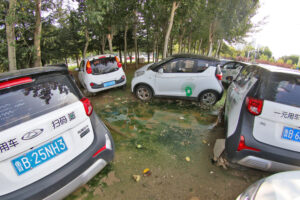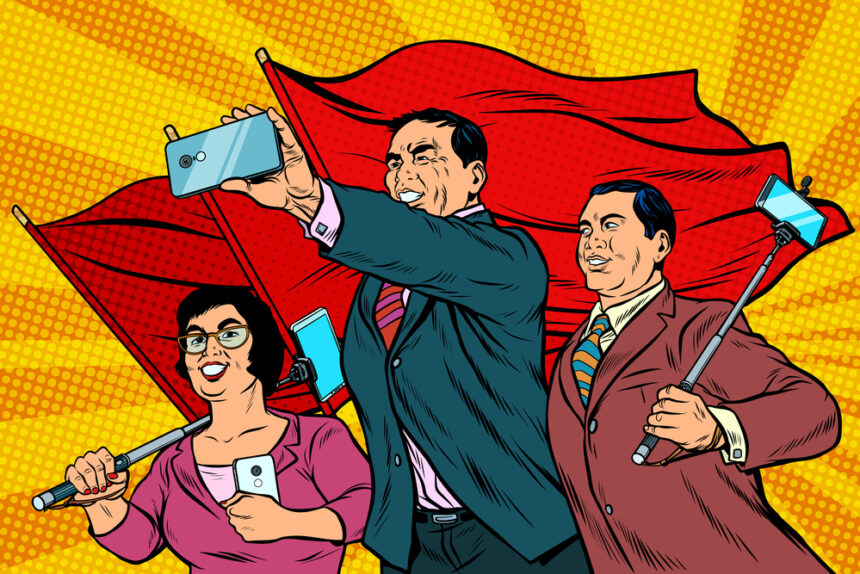
The contrast often presented between America and China is one where Beijing is a highly competent, well-oiled autocracy while the United States is a political circus held back by partisan drama. On the surface, and especially with recent news headlines, this may seem true. One might recall Senate Republican leader Mitch McConnell staring blankly into space in the middle of a press conference, President Joe Biden making frequent gaffs while his opposition chants “Let’s Go Brandon”, or any number of inelegant moments from former President Donald Trump. Indeed, with election season underway, both sides are showing just what a circus they can put on. Meanwhile, the story goes that the Chinese are orchestrating a series of well-organized and nefarious plans such as winning the quiet war of global governance. All the while Xi Jinping is also seemingly able to launch one sweeping policy campaign after another. Although these headlines and comparisons look true on the surface, a deeper analysis of the situation shows that China is facing real and substantial problems in its quest to centrally plan all of Chinese life. These problems may not get as many media hits as the decline of the dollar and the mishaps of the U.S. politicians, but they are issues that leave the Chinese Communist Party (CCP) in a far less secure position than it appears.
Government Structure
The Chinese government cultivates an image of an efficient and focused regime with its technocratic leadership that when compared to the complicated partisan gridlock that often is the reality of the U.S. government appears far better than it is. During the outbreak of the Covid-19 pandemic, stories highlighted the swiftness with which the Chinese government was able to build hospitals and take decisive action. Meanwhile, the United States was mired in partisan arguments, and constitutional checks and balances left decision makers without the unilateral authority they wanted. What those with a working knowledge of China, and what is even more apparent today, is that China’s authoritarian system produced its own structural failures. From the very outset, local officials were incentivized to minimize information about the outbreak as promotions and their jobs were contingent on producing good news about the crisis. Officials in Wuhan feared that sharing information that suggested anything other than that they were effectively managing every aspect of the outbreak would be punished. Indeed, the whistleblower doctor who helped break the news about the virus was silenced by local authorities for “spreading rumors” and only remembered as a hero after large-scale public outcry.
Although China’s response was swift and aggressive, it would ultimately suffer from the undermining of civil liberties, checks and balances, and political freedom that typifies the Chinese system. The most emblematic blunder was the ordeal of Beijing’s “Zero Covid” strategy. This attempt to contain the highly contagious, but less fatal, Omicron variant, employed a draconian lockdown strategy at the same time the rest of the world had begun a return to normalcy, fueled by vaccine deployment and natural immunity rates. This led to China being effectively cut off economically from the trade vital to powering its economy. The CCP’s doubling down on a lockdown doctrine while also eschewing Western vaccines to promote its own less effective domestic versions, led to disastrous results. Entire cities, such as the bustling metropolis of Shanghai, were shut down to the point citizens ran low on food reserves and many were trapped in their homes for extended periods. Meanwhile, pride and adherence to the supremacy of the CCP’s policy prevented the deployment of advanced Western vaccines produced by Moderna and Pfizer. At the same time, the CCP pushed e of its domestic Sino-Vac line which top officials admitted were not nearly as effective.
Criticism of the Zero-Covid strategy was highly discouraged and censored because it was the signature policy of Xi Jinping and a symbol of Beijing’s competence and efficiency, even as the economy stalled. Indeed, Zero-Covid only ends after Xi’s reappointment to rule for a third term as leader and a declaration of the full success of the policy.
Virtually overnight, lockdowns were suddenly lifted, unleashing the contagious Omicron variant upon a population that had low rates of natural immunity or vaccination, leading to massive spikes in infections and a significant number of deaths. Meanwhile, economic growth rebounded briefly but then stalled once again as businesses and capital rich citizens began to hedge the political risk created by the CCP’s power maximizing behavior by moving investments to neighboring markets like Singapore and Thailand.
Rewarding Politics Over Results
For aspiring bureaucrats who fell in line with Xi’s mandate, promotion to national leadership positions in the Politburo, the CCP’s leadership organ, followed. Indeed, despite the public outcry surrounding Xi’s Zero-Covid response, his grip on power increased following the 20th Party Congress in 2022 when he replaced all his political opponents on the Politburo Standing Committee, the country’s highest governing body, with his allies. In particular, Li Qiang and Cai Qi, the mayors of Shanghai and Beijing who oversaw the widely condemned covid responses in Shanghai and Beijing, were elevated to Standing Committee positions for their loyalty, and willingness to follow the leader despite disastrous consequences.
These political realities have significantly harmed business confidence in China and Chinese nationals have increasingly hedged their assets by purchasing property in foreign countries and positioning their wealth for mobility. Taken as a whole, these blemishes strongly suggest an overall narrative of a hyper competent and efficient autocratic regime is inaccurate.
“In virtually every area of Chinese political and economic life the disruptions of autocratic technocracy are only thinly veneered by the perception of decisive and efficient leadership.”
The central planning failures extend beyond the pandemic blunders. Zero-Covid and the economic slowdown in its wake is one of many policy miscalculations and excesses enabled by China’s authoritarian system. In virtually every area of Chinese political and economic life the disruptions of autocratic technocracy are only thinly veneered by the perception of decisive and efficient leadership. Examples of this reality can be found throughout China.

For example, in August of 2023, Bloomberg reported on a growing problem in China of massive collections of unused electric cars, which are not only a waste of resources but cause negative environmental impacts. These electric car ‘graveyards’ came from the government’s subsidization of the EV market for both economic and geopolitical goals. Beijing saw the development of EVs as a key emerging technology and the CCP believed that EV sales would be key in spreading Chinese influence globally. Beijing poured subsidies into the electric auto market creating an explosion of output and even the creation of new ride hailing services to absorb excess vehicle production.
Once the government began slashing state aid because of the excess vehicles ending the artificially sustained market, what had been a 500 firm industry shrunk to just 100 by 2023. Many of the cars produced by government mandate and subsidy featured dismal range, less than 100 miles per charge, a reality that was particularly problematic because Chinese infrastructure lacked and still lacks the charging stations to sustain a substantial EV driving populace. China’s already strained traffic and parking capacity only made the situation worse as car owners found it more advantageous to abandon their vehicles rather than attempt to sell them. Despite Xi’s speeches about the importance of a vibrant and productive private sector, the CCP as central planner of private enterprise is the norm and has increased under Xi leading to near disastrous results.
In an attempt to control the economic sector “The Opinion on Strengthening the United Front Work of the Private Economy in the New Era” was released in 2020. It signaled the reassertion of Party power in both private and state owned entities, with the CCP maintaining a direct involvement in corporate HR departments and corporate governance. Despite its sweeping grant of authority, the directive was only the beginning of Xi’s assertion of Party authority. In 2021, Xi announced the Common Prosperity, an unprecedented regulatory and income redistribution campaign focused on China’s largest companies. The campaign consisted of highly aggressive, ad hoc regulatory crackdowns involving vague citations to anti-monopoly laws, data privacy, and other black letter rules. Another key component was state encouraged philanthropy that saw China’s elite transfer over $10 billion to various approved social causes. Although ultimately a failure in achieving its lofty goals of fixing China’s structural ills, Common Prosperity clearly shows how the political priorities of the CCP are enabled by an authoritarian system with little checks and balances.
In response to criticism, the CCP would say that the aggressive, ad hoc antitrust actions taken against large firms like the e-commerce giant Alibaba and ride hailing service Didi corrected years of lax enforcement and forwarded the interests of a Chinese public weary of corporate power. Again, the power play took priority. The crackdown reminded private firms that the CCP was ultimately in charge of all aspects of China.
China’s sudden and unrestrained crackdowns on its tech companies has been viewed by some as a bold step for antitrust law, unburdened by Western style checks and balances. The results, however, discredit the idea and show that such attempts do not lead to a new era of “10,000 little giants” with multiple Amazon and Google type companies competing against one another, but instead the assault on its most lucrative companies led to a sharp increase in youth unemployment and economic uncertainty.
Xi’s Political Dilemma
The maximization of political influence with almost no institutional checks and balances has characterized Chinese politics since the earliest days of the Communist regime. Xi Jinping’s version of this power-maximizing regime has served him well, but today’s Chinese leaders who lack Xi’s political savviness have become losers in the system. Although in the United States we may lament the entrenched nature of partisan interest groups and career politicians and wonder how seemingly unpopular political parties stay in power, China has its own far worse systemic problems.
Although the CCP is one political party, it is filled with different factions, including the hardline communists, economic reformers, personal patronage groups, the military industrial complex, and regional interest groups. Rising to the top in the mold of Xi Jinping is not as simple as unifying the country under a competent and clear vision. Xi, like most authoritarian leaders, rose to the top through complicated and entangled alliances, making promises to interest groups, plus purging and imprisoning his enemies. For this reason, especially following his numerous anticorruption purges that targeted both genuinely corrupt individuals and political enemies, many speculate that Xi cannot leave power without facing retribution. As a result, his leadership going forward will be increasingly colored by this dilemma and potentially undermine his ability to make prudent decisions.
United States Competition with China
Many look toward the confusion and disagreement present in the United States on foreign policy with its passionate debates over nationalism and internationalism, and free trade over protectionism and arrive at a fatalistic belief of the inevitability of a loss to China. Although China does not have the same fervent debates, it does suffer from the opposite problem, as there are too few voices to challenge unproductive ideas and temper runaway nationalism and state. The common narrative has been that the CCP engages in 100-year plans, slowly biding its time and expanding its influence across the world in ingenious ways. Although Beijing has had some success in living up to that narrative, recent events have proven to be a rude awakening. The CCP’s relationships with major trade centers like the European Union and neighboring powers like India and Japan have become complicated and increasingly adversarial.
Chinese leader Deng Xiaoping articulated a hide and bide strategy. This doctrine would see China continue to grow its industrial, military, and diplomatic capabilities while prioritizing friendly relationships with all nations and never taking a leadership role. The strategy was practiced for decades gaining Beijing substantial influence in the global economy. Indeed, foreign policy attempts such as “derisking,” and creating economic solidarity to resist Chinese sanctions were initially ignored and seen as American unilateralism. Today, countries are far more open to the prospect of jeopardizing economic relations with China in favor of security and tempering the balance of power in the Indo-Pacific than they were even just a few years ago. This dynamic is due to both natural balancing tendencies that follow Beijing’s accumulation of power as well as its own actions that have exacerbated tensions with the West and its neighbors.
Conclusion
The United States, with its seemingly chaotic politics, a free press, and partisan debate, often plagued with gridlock and identity politics, is easy to look at as an example of dysfunctional governance. Meanwhile, the Chinese have become a global superpower and have moved a huge population out of poverty within a single lifetime. These accomplishments are largely attributable to structural factors, such as having a massive population and removing decades of self-inflicted restraints that unleashed massive productive energy. In short, China’s growth story occurred despite the government’s interventions not because of some technocratic plan. Indeed, today the headlines are filled with articles highlighting China’s stagnation and the idea of “peak China” as the government imposes new restrictions.
The reality is that China is not a singularly competent, well-oiled autocracy that will inevitably succeed. Instead, the CCP faces the real problems inherent to their authoritarian rule, such as formidable interest groups bent on preserving unproductive state enterprises, misallocation of capital from decades of industry policy, and loss of business confidence from recent attempts to insert the Party in daily life. The actions of the CCP in navigating the political complexities of staying in power have led to policy decisions and repression that ultimately harm long term economic growth and quality of life. Despite the problems inherent to America’s system of governance, China faces formidable problems of its own that are increasingly devastating. The United States should not lose hope in its liberal democratic form of government and free market system that has largely delivered both freedom and prosperity.
Footnotes
(1) “Doctor who blew whistle over coronavirus has died, hospital says,” by Emma Graham-Harrison, Tom Phillips, and Justin McCurry. BBC, February 6, 2020.
(2) “China’s Xi unwilling to accept western vaccines, U.S. official says,” by Michael Martina and David Brunnstrom. Reuters, December 4, 2022.
(3) “Wealthy Chinese ramp up efforts to shift fortunes overseas,” by Pak Yiu and Echo Wong. Nikkei Asia, February 12, 2023.
(4) “Around the Halls: The outcomes of China’s 20th Party Congress,” by Richard C. Bush, Diana Fu, Ryan Hass, Patricia M. Kim, and Cheng Li. Brookings Institute, October 25, 2022.
(5) “China’s Abandoned, Obsolete Electric Cars Are Piling Up in Cities.” Bloomberg News, August 17, 2023.
(6) “The Chinese Communist Party Targets the Private Sector,” by Scott Livingston. Center for Strategic and International Studies, October 8, 2020.
(7) “Tech titans hew to China’s ‘common prosperity’ call, as 49 richest tycoons donate a record US$10 billion of their wealth,” by Martin Choi. South China Morning Post, November 16, 2022.
(8) “Why China crushed its tech giants,” by Lavender Au. Wired, September 27, 2023.
(9) “Unsafe at the top: China’s anti-graft drive targets billionaires and bankers,” by Amy Hawkins. The Guardian, April 18, 2023.
(10) “Is Chinese power about to peak?” The Economist, May 11, 2023.
* Dr. Ryan M. Yonk is Senior Research Faculty at the American Institute for Economic Research, and Co-Author of The China Dilemma: Rethinking US-China Relations Through Public Choice Theory. His research explores how the intersection of public choice and public policy and how policy can be better crafted to achieve greater individual autonomy and prosperity.
Ethan Yang is an adjunct research fellow at the American Institute for Economic Research, Co-Author of The China Dilemma: Rethinking US-China Relations Through Public Choice Theory. His research focuses include Chinese political economy, international affairs, tech policy, and law and economics.
This article was edited by Features Editor Ed Lopez.




